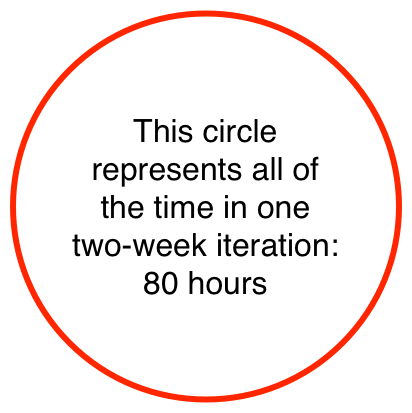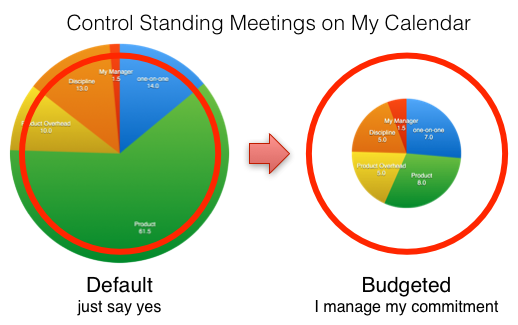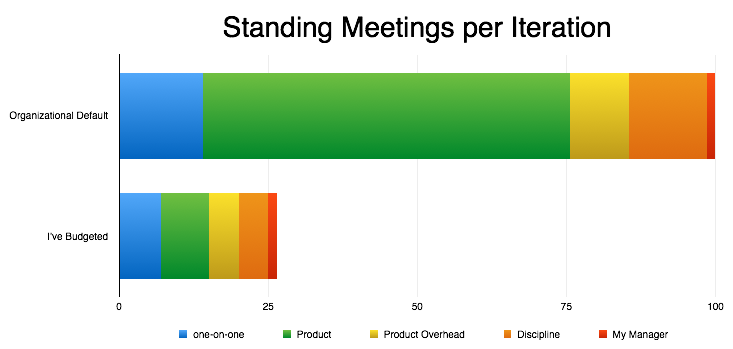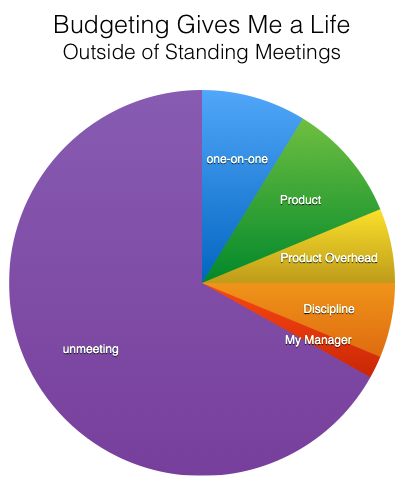Some time last year I realized that if I scheduled every meeting I’m “supposed to” schedule, and accepted the standard meetings others are “supposed to” schedule it would add up to more than 40 hours in meetings every week.
Up to this point I had been scheduling, accepting, and rejecting meetings in a one-off way. Realizing that I couldn’t possibly attend all the meetings I was expected to attend I decided that I need a rule — some guideline I can believe in to help me put limits on the time I spend in meetings.
The One Third Rule
In college they told me to plan on two hours of homework for every hour in class. I started there with my standing meetings:
Spend no more than a third of your time in standing meetings.
The Chains of Standing Meetings
A standing meeting is like a mortgage payment: slavery.
Ok, not really. But a standing meeting is pre-spent time.
I believe they can be useful. Perhaps I will get to a point when I do most of my work in a meeting. So far I find that meetings still have a way of giving me homework. (That is, the work isn’t done in the meeting.)
I was tired of going to meetings where the only time I dedicated to that group was time in meetings.
Where Was I? Time Bankruptcy
I felt stretched. I wondered if there was something I could put my finger on more than that feeling. I tallied up my directs and committee assignments to see how much time I should be spending in standing meetings. Here’s what I got:
If I attended every standing meeting that we commonly expect a functional manager to attend then it would total 100 hours every iteration (that is, every two weeks).
“Yes Sir,” Sometimes Bad
How did I get there? Fourteen directs, seven product teams, two product portfolio committees, five miscellaneous engineering committees, six functional councils or staff meetings, plus my own one-on-one with my boss.
I can’t possibly attend all those meetings. You can’t even get the scheduling right. Plus, if I’m going to add value to any of those assignments I need to spend no more than 27 hours in meetings every two weeks.
To see it in pictures, heres all the time in an iteration:

Here’s all the standing meetings I would have to attend if I attended them all:
Limit Attendance. Give Time to Do
If I switched to biweekly one-on-ones, attended the first half hour of committee meetings, and sampled or eliminated attending execution oriented product team meetings like stand-up, review, retrospective, and planning then I could get under my one third budget:
The pie-charts above are to scale. To see it another way check out these bars:
Maximize Small Meetings
You’ll notice that following this budget increases the proportion of my time spent with direct reports and my job function (discipline), which is my primary concern.
This allows me to spend more time in small meetings and less time in large meetings. I make a bigger difference in an intimate setting.
Finally, it gives me much more time for ad-hoc meetings and applying my expertise outside of meetings:
I Did It
I posted my musings with the warning,
This might be why I turn down your meeting or let you know I can only attend the first half hour.
I spaced out my schedule, told people I couldn’t attend their whole meeting, and pretty much took control of my time. No one really noticed much, and I felt great.
You Can Do It
You can manage your calendar. In fact, you must. No one else is managing your time. They may demand it, but they aren’t managing it.
When you turn down a meeting, or ask for it to be shorter, or that you might leave early, most of the time people won’t say anything. If they do just tell them this is all the time you have for their item. When the occasional organizer insists you can stand your ground or give in.
Either way, you’ll spend less time in meetings overall and probably not miss much.





